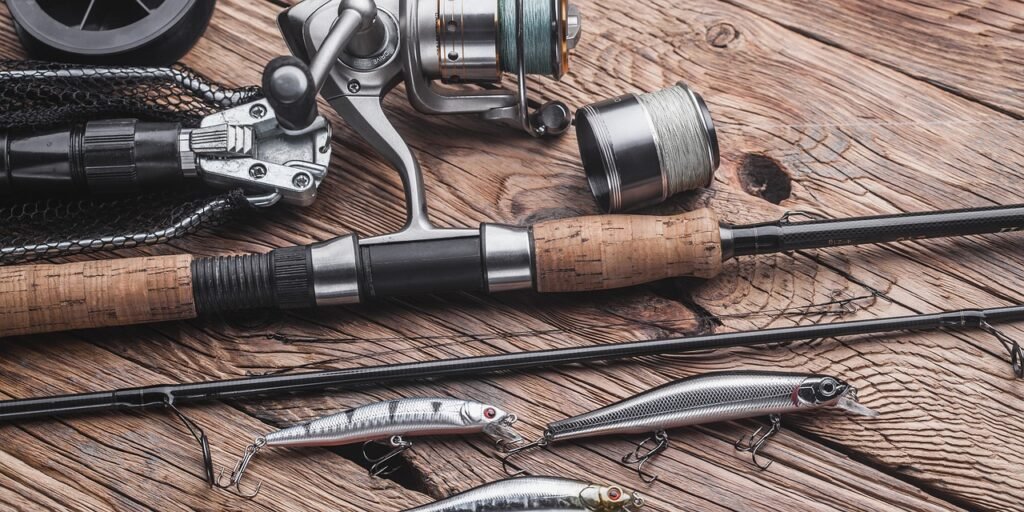Fishing is more than just a hobby; it’s a passion, a way to connect with nature, and for many, a lifelong pursuit. Whether you’re casting a line into freshwater lakes or braving the waves for some saltwater fishing, having the right gear can make all the difference. One of the fundamental choices every angler faces is selecting between telescopic rods and traditional rods. Let’s dive into the pros and cons of each to help you choose the best tool for your next fishing adventure.
The Tale of Two Rods
Traditional Rods: Tried and True
Traditional fishing rods are the classic choice for anglers. Typically made from high-quality materials like graphite or fiberglass, these rods come in one or two-piece designs. They have been a staple for fishing enthusiasts for decades, offering a blend of performance and reliability that is hard to beat.
Pros:
- Performance and Sensitivity: Traditional rods, such as the St. Croix Premier Spinning Rod, are known for their excellent sensitivity and performance. Because they have fewer joints, they offer smoother action and better power transfer. This makes it easier to feel even the slightest nibble, giving anglers an edge in detecting fish. The responsiveness of these rods enhances the overall fishing experience, making them a popular choice for serious anglers.
- Durability: With fewer moving parts, traditional rods tend to be more durable. The G. Loomis E6X Casting Rod is renowned for its robustness and longevity. These rods are designed to withstand the rigors of frequent use and harsh conditions, ensuring they remain reliable over time. The solid construction also means they are less likely to break or malfunction during a crucial moment, providing peace of mind for anglers.
- Variety: Traditional rods come in a wide range of lengths, powers, and actions, offering tailored options for specific types of fishing. For example, the Shimano Teramar TMS Spinning Rod is perfect for inshore saltwater fishing, while the Ugly Stik Elite Spinning Rod is a favorite among freshwater anglers. This variety allows anglers to choose a rod that perfectly matches their fishing style and target species, enhancing their chances of success.
Cons:
- Portability: Traditional rods can be cumbersome to transport, especially the longer models. They often require special rod cases or carriers. Packing these rods for a trip can be a hassle, particularly if you are traveling by plane or have limited space in your vehicle. The inconvenience of transporting them can be a significant drawback for anglers who frequently travel to different fishing locations.
- Storage: Storing traditional rods can be challenging if you don’t have ample space. Their length can make them difficult to fit in small cars or tight spaces. Proper storage is essential to maintain the rod’s condition, but finding the right spot in a cramped home or apartment can be difficult. This issue can deter some from choosing traditional rods, despite their other advantages.
Telescopic Rods: Convenience on the Go
Telescopic rods are designed to collapse down into a compact size, making them incredibly portable and easy to transport. These rods are often crafted from high-quality materials like carbon fiber, which strikes a balance between strength, flexibility, and lightweight construction. Telescopic rods are particularly favored by anglers who need their gear to be versatile and travel-friendly.
Pros:
- Portability: The hallmark of telescopic rods is their convenience. The Daiwa Megaforce Tele Spin rod, for instance, can collapse to just a fraction of its extended length, making it easy to carry in a backpack, car trunk, or luggage. This makes them ideal for spontaneous fishing trips or multi-day adventures where storage space is at a premium.
- Storage: Telescopic rods are great for anglers who are short on storage space. They can easily fit into small compartments, making them an excellent choice for travel. Whether you live in a small apartment or travel frequently, a telescopic rod offers a practical solution to the problem of limited storage.
- Versatility: Many telescopic rods, like the KastKing BlackHawk II, are designed to handle a variety of fishing situations, from freshwater ponds to saltwater bays. This versatility means one rod can serve multiple purposes, saving you the hassle and expense of maintaining an extensive collection of fishing gear.
Cons:
- Durability: Telescopic rods have more joints and moving parts, which can make them less durable compared to traditional rods. They are more prone to wear and tear, especially if not properly maintained. Regular cleaning and careful handling are essential to extend the lifespan of these rods. Additionally, anglers should be aware that the extra joints may be potential weak points.
- Performance: While modern telescopic rods have improved significantly, they may still fall short in sensitivity and power transfer compared to their traditional counterparts. The joints and collapsible sections can sometimes affect the rod’s overall feel, making it less responsive. For those who prioritize precision and performance, this can be a notable drawback. However, advancements in technology continue to narrow the gap between telescopic and traditional rods.
Technical Comparisons
Materials
- Traditional Rods: Often constructed from materials such as graphite or fiberglass, these rods provide a perfect balance of strength, flexibility, and sensitivity. Graphite rods are favored for their lightweight nature and responsiveness, making them ideal for anglers who need to detect subtle bites. Fiberglass rods, on the other hand, are known for their durability and ability to handle larger, more aggressive fish.
- Telescopic Rods: Commonly made from carbon fiber, these rods are both lightweight and strong, making them great for travel and portability. However, due to the multiple sections that allow them to collapse, they can sometimes be less durable than traditional one-piece rods. Despite this, advancements in manufacturing have significantly improved their resilience and usability over the years.
Action and Power
- Traditional Rods: These rods offer a wide range of action (how much the rod bends) and power (rod strength) to suit various fishing styles. For instance, the Fenwick HMG Spinning Rod is renowned for its fast action and medium-heavy power, making it versatile enough to handle a variety of fishing techniques, from freshwater to light saltwater angling. Traditional rods can be customized to meet the specific needs of different fish species and environments.
- Telescopic Rods: Generally designed to offer moderate action and power, telescopic rods are suitable for general use but may not cater to specialized fishing techniques as effectively as traditional rods. They are particularly popular among traveling anglers who need a compact and portable option. While they may not offer the same level of customization, modern telescopic rods have become quite efficient for a broad range of fishing scenarios.
Cost
- Traditional Rods: The price of traditional rods can vary widely based on factors such as brand, materials, and construction quality. High-quality models like the Orvis Clearwater Fly Rod tend to be more expensive but provide superior performance, durability, and a better overall fishing experience. These rods are often considered long-term investments for serious anglers who prioritize quality and precision.
- Telescopic Rods: Typically more affordable, telescopic rods offer great value, especially for beginners or those looking for a convenient secondary rod. While they may not match the performance of high-end traditional rods, they are an excellent choice for occasional anglers or those who need a portable fishing solution. The lower cost also makes them accessible to a wider range of users, enabling more people to enjoy the sport of fishing without a significant financial commitment.
Which One Should You Choose?
Choosing between a telescopic and a traditional rod ultimately depends on your fishing style, needs, and preferences. Both types of rods come with their own set of advantages and can cater to different fishing scenarios.
- Best Overall: If performance and durability are your top priorities, a traditional rod like the St. Croix Premier Spinning Rod is an excellent choice. This rod is renowned for its high sensitivity, which allows anglers to detect even the slightest bites. Its robust construction, made from premium SCII graphite, ensures longevity, making it suitable for serious anglers who demand reliability and precision in their equipment. The rod also features aluminum-oxide guides and a Fuji DPS reel seat, adding to its durability and performance.
- Best for Portability: For those who value portability and convenience, the Daiwa Megaforce Tele Spin offers a great balance of performance and compactness. This telescopic rod is perfect for fishing enthusiasts who frequently travel or hike to their fishing spots. Its collapsible design makes it easy to pack and carry without compromising on the quality of the fishing experience. The rod is constructed from high-quality carbon fiber, ensuring that it remains lightweight yet strong enough to handle various fishing conditions. Additionally, the rod features a comfortable EVA handle, making it easier to grip during long fishing sessions.
- Best Value: If you’re looking for a versatile and budget-friendly option, the KastKing BlackHawk II telescopic rod is a great choice. Designed to handle various fishing conditions, this rod provides a good balance of flexibility and strength. It’s a cost-effective option for both beginners and seasoned anglers who want a reliable rod that won’t break the bank. The BlackHawk II is made from high-density carbon fiber mixed with fiberglass, which enhances its durability and performance. It also features multiple floating guides, which improve casting performance and reduce line friction, ensuring a smoother fishing experience.
In summary, your choice should reflect your individual needs and fishing goals. Whether you prioritize performance, portability, or value, there’s a perfect rod out there for you. Happy fishing!
Conclusion
Both telescopic and traditional rods have their unique advantages and drawbacks. Traditional rods excel in performance and durability, making them ideal for dedicated anglers. On the other hand, telescopic rods offer unmatched convenience and portability, perfect for those who travel frequently or have limited storage space.
In the end, the best rod is the one that fits your specific needs and lifestyle. Happy fishing, and may your next catch be your best one yet!



